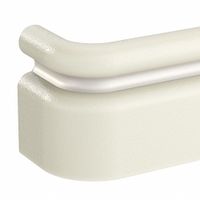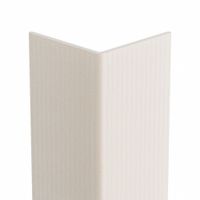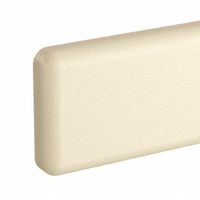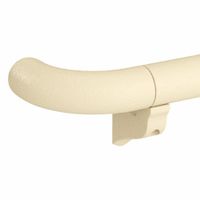Call +(254) 703 030 000 / 751 483 999 / 721 704 777
.....Read More
Frequently Asked Questions
What are corner guards and how do they work?
Corner guards are protective barriers designed to prevent damage to building corners from impacts by carts, trolleys, wheelchairs, or general foot traffic. They are commonly used in commercial, institutional, and industrial settings such as hospitals, schools, warehouses, and retail stores where walls are prone to wear and tear.
Corner guards work by absorbing the impact of collisions, distributing the force across a larger surface area, and protecting the vulnerable corner edge from chips, dents, and scuffs. They are typically made from durable materials like PVC, rubber, stainless steel, or aluminum, chosen for their resilience and ability to withstand repeated impacts.
Installation methods vary, but most corner guards are either surface-mounted (adhered with construction adhesive or screwed into the wall) or flush-mounted (recessed into the wall for a seamless appearance). Some designs also incorporate internal cushioning for enhanced impact absorption. By shielding corners, these guards extend the life of walls, reduce maintenance costs, and improve the overall aesthetics of a building.
How do wall protection systems prevent damage in high traffic areas?
Please provide the question you would like me to answer.
What materials are commonly used for corner guards and wall protection?
Common materials used for corner guards and wall protection include: * **Vinyl:** A popular and versatile option, vinyl offers good impact resistance, is easy to clean, and comes in a wide range of colors to match various interior designs. It's often used in healthcare facilities, schools, and commercial buildings.
* **Acrovyn:** A proprietary blend of PVC and acrylic, Acrovyn is known for its extreme durability and resistance to scratches, dents, and abrasion. It's frequently specified for high-traffic areas and demanding environments.
* **Rubber:** Ideal for industrial settings, loading docks, and parking garages, rubber corner guards provide excellent impact absorption and protect against heavy machinery and vehicle damage. They are very robust and weather-resistant.
* **Stainless Steel:** Offering a sleek, modern look, stainless steel corner guards are highly durable, corrosion-resistant, and easy to sanitize. They are often used in commercial kitchens, laboratories, and other areas requiring hygiene and strength.
* **Polycarbonate:** A transparent and incredibly strong thermoplastic, polycarbonate is used for applications where visibility of the wall behind is desired, such as in retail displays or areas where aesthetics are critical. It offers high impact resistance.
* **Wood:** For a more traditional or decorative aesthetic, wood corner guards can be used. They are often found in homes, offices, and hospitality settings where a natural or classic look is preferred, though they offer less impact protection than other materials.The choice of material depends on factors such as the level of impact expected, aesthetic requirements, budget, and specific environmental conditions.
How do you install handrails and wall guards?
Installing handrails and wall guards involves several steps to ensure safety and proper functionality. First, determine the desired height and location of the handrails and wall guards, often referencing local building codes and ADA guidelines. Mark the stud locations on the wall, as these will provide the most secure anchoring points.
Next, pre-drill pilot holes at the marked stud locations. If no studs are available, use appropriate wall anchors for the wall material (e.g., toggle bolts for drywall, expansion anchors for concrete). Attach the mounting brackets to the wall using the recommended fasteners, ensuring they are level and securely fastened.
Once the brackets are in place, the handrail or wall guard material can be cut to the appropriate length. Carefully attach the handrail or wall guard to the brackets, typically using screws or other fasteners provided by the manufacturer. Ensure all connections are tight and secure. Finally, inspect the installation for any wobbling or loose points, making adjustments as needed. For wall guards, it's also important to consider corner protectors and end caps for a finished look and added durability.
What are the benefits of using crash rails and bumper guards?
Crash rails and bumper guards are protective barriers designed to prevent damage to walls, equipment, and vehicles in high-traffic areas. They offer several benefits, including: * **Damage Prevention:** They absorb impact from carts, machinery, and vehicles, preventing costly repairs to walls, corners, and fixtures. This extends the lifespan of infrastructure and reduces maintenance expenses.
* **Safety Enhancement:** By clearly delineating pathways and providing a physical barrier, they can prevent accidental collisions and protect pedestrians from moving objects, improving overall safety in industrial, commercial, and healthcare settings.
* **Aesthetic Preservation:** They shield surfaces from scuffs, dents, and scratches, helping to maintain a clean and professional appearance in public spaces, hallways, and loading docks.
* **Cost Savings:** By preventing damage, they reduce the need for frequent repairs and replacements of building materials and equipment, leading to significant long-term cost savings.
* **Versatility:** Available in various materials, designs, and colors, they can be customized to suit different environments and aesthetic requirements, from heavy-duty industrial applications to subtle architectural enhancements.
How do combined handrail and wall guards enhance safety?
Combined handrail and wall guards significantly enhance safety by serving a dual purpose in various environments, particularly in healthcare facilities, educational institutions, and commercial buildings. Handrails provide crucial support for individuals, aiding in balance and preventing falls, especially for those with mobility challenges. This is particularly important in corridors, stairwells, and ramps where stability is key.
Simultaneously, the wall guard component protects the structural integrity of walls from impact damage caused by carts, gurneys, wheelchairs, or general foot traffic. This not only maintains the aesthetic appeal of a space but also prevents costly repairs and ensures a safer environment by eliminating potential hazards such as cracked or damaged walls.
The synergistic effect of these two features is what truly maximizes safety. By integrating a handrail into a wall guard, the system offers a continuous line of protection and support. Users can rely on the handrail for stability, while the robust wall guard prevents accidental damage that could lead to trip hazards or compromising the building's infrastructure. This integrated design is more efficient and effective than installing separate handrails and wall guards, leading to improved safety, durability, and a more streamlined appearance.
What is the best way to protect walls from door handle impacts?
To protect walls from door handle impacts, consider installing door stoppers. There are several types: floor-mounted stoppers, which are durable and discreet; baseboard-mounted stoppers, which are easy to install and blend with existing trim; and hinge pin stoppers, which attach to the door hinge and are nearly invisible. Adhesive wall protectors, often clear or decorative, can also be applied directly to the wall at the point of impact. For a more integrated solution, consider recessed door stops that are installed flush with the wall. The best choice depends on your aesthetic preferences, the wall material, and the weight and frequency of door use.
How do protective wall panels differ from other wall protection products?
Protective wall panels are designed to safeguard walls from impact, abrasion, and moisture, offering a more robust and permanent solution compared to other wall protection products. Unlike paint or wallpaper, which primarily serve aesthetic purposes and offer minimal protection, panels are typically made from durable materials like PVC, acrylic, or stainless steel, providing superior resistance to damage.
While corner guards and crash rails offer localized protection, wall panels provide comprehensive coverage for larger wall areas. Wall panels are often engineered for specific environments, such as healthcare facilities needing antimicrobial properties or industrial settings requiring high impact resistance. They are also easier to clean and maintain than painted or textured walls, making them ideal for high-traffic areas. The installation of wall panels is generally more involved than applying paint or adhesive wall coverings, but their longevity and protective qualities often make them a more cost-effective long-term solution.
What are the advantages of using wall rub rails and strips?
Wall rub rails and strips offer several advantages, primarily in protecting walls and equipment from damage due to impacts. They act as a buffer, absorbing force from carts, gurneys, equipment, or even pedestrian traffic. This significantly reduces maintenance costs by preventing scuffs, dents, and punctures to drywall, paint, and other wall finishes.
Beyond protection, rub rails and strips can also improve the aesthetic appeal of a space by maintaining clean and undamaged walls, especially in high-traffic areas. They are commonly used in hospitals, schools, retail environments, and industrial facilities, where the risk of wall damage is high. Different materials, such as rubber, vinyl, and stainless steel, offer varying levels of durability and aesthetic options to suit specific needs and environments. Their installation is relatively straightforward, and they provide a long-lasting solution for wall preservation.
How do wall handrail adhesives and sealers work compared to mechanical fasteners?
Wall handrail adhesives and sealers offer a less invasive and often more aesthetic alternative to mechanical fasteners. Adhesives create a strong bond by chemical or physical means, adhering the handrail directly to the wall surface without the need for drilling or visible screws. This can result in a cleaner finish and prevent damage to the wall substrate. Sealers, while sometimes having adhesive properties, primarily act as a barrier against moisture and other environmental factors, enhancing the durability of the installation and preventing corrosion or degradation.
In contrast, mechanical fasteners, such as screws, bolts, or anchors, secure the handrail by physically penetrating the wall. This method provides a very strong and immediate connection, and its strength is largely dependent on the type of fastener and the integrity of the wall material. While mechanical fasteners are typically robust and reliable, they can be more labor-intensive to install, may require patching and painting for a finished look, and can be less suitable for certain delicate or decorative wall surfaces. The choice between adhesives/sealers and mechanical fasteners often depends on factors like the handrail's weight, the wall material, desired aesthetic, and load-bearing requirements.







